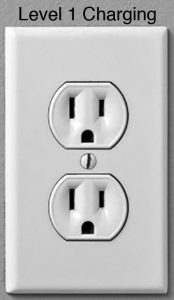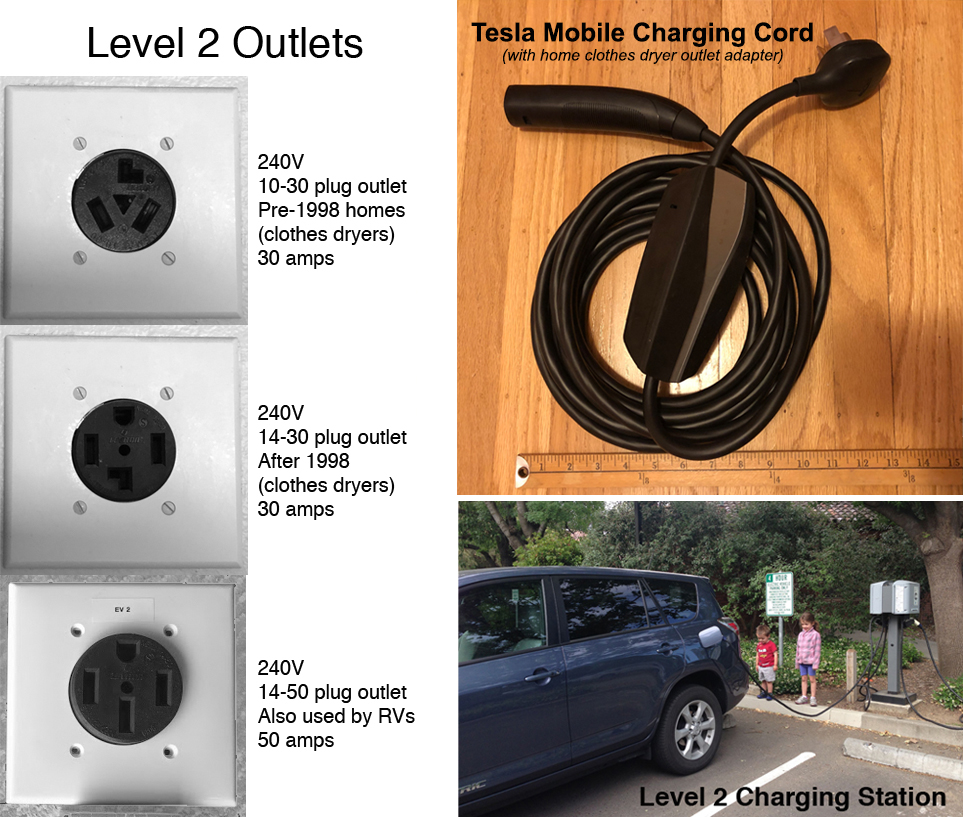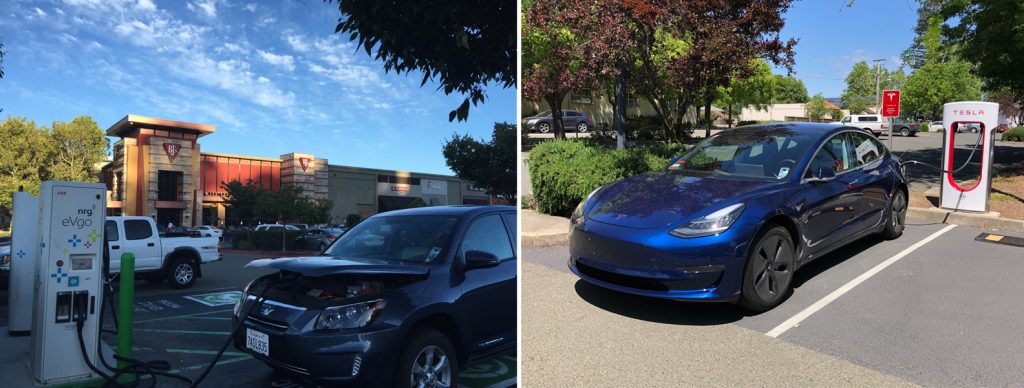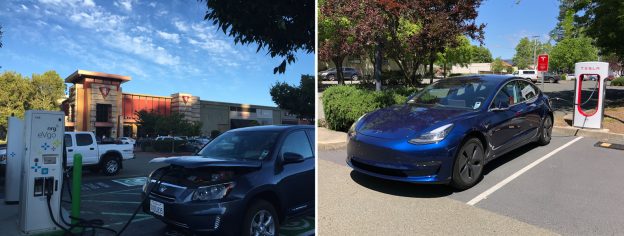In one respect charging an electric car is no different than filling a gas tank: it’s all about storing energy in the car to power its motor. We use electricity every day to power and charge all kinds of devices: phones, computers, shavers, televisions etc. But since driving an electric powered car is still a new idea for many people, it might help to be familiar with the terms you’ll be using, so we’ll cover that first.
When charging an electric car, Volts and amps matter. There are three major categories, or Levels, of EV charging that range from very slow to very fast depending on the number of Volts and amps. Keep in mind that the fastest charge isn’t always the best solution. First a quick word on power versus energy may be useful:
Power and energy:
Power is measured in kiloWatts (kW) and represents how fast you can charge your car. Power is calculated by multiplying the number of Volts by the number of amps. A public charging station that operates at 208V and 30amps provides 208 X 30 = 6,240W or 6.2 kW of power. The more power, the faster the charge. The current range of power used for charging electric cars varies over 100-fold from about 1.8 kW to over 200 kW. Tesla’s newest V3 Supercharging stations can reach a peak power that approaches 250 kW.
Energy represents the electricity stored in your battery pack and is measured in kiloWatt hours (kWh). Many EVs on the market in 2018 have battery packs that store between 30 to 100 kWh of energy. For comparison, a gallon of gas has 33.7 kWh of energy, so EVs have the energy equivalent of only 1-3 gallons of gas on board. But EVs are much more efficient than gas-powered cars, so you can drive a lot farther with less energy stored on board.
Types of Charging:
Level 1: (110-125V) Charging an EV by plugging into a standard outlet found in any home in the US. The standard outlet provides 120V and 15 amps, and therefore 120 X 15 = 1.8 kW. (Home outlets are 230V in many other countries). Most EVs are sold with a 120V charging cable that can be plugged into a 120V outlet. Level 1 is the slowest way to charge an EV and adds about 3 or 4 miles of range to the battery for each hour of charging. But Level 1 charging works for those who can leave their car plugged in overnight and who drive up to 35-40 miles per day.

Standard 120V home outlet in the United States.
Level 2: (200-240V) Plugging your EV into a 200-240V public charger or outlet. Many public chargers operate at 208 Volts and 30 amps = 6.2 kW. These 208V / 30A public charging stations add about 20 miles of range to your car per hour. 240V outlets are also found in many homes and are used for appliances like clothes dryers. A typical clothes dryer is plugged into a 240V, 30 amp outlet. 50 amp outlets are less common in homes, but can be installed and are also found in some RV parks. Charging an EV on a 50A circuit yields 25 or more miles of range per hour charging. The Tesla mobile charging cord, which comes with each new Tesla, can charge at 120V or 240V using a set of adapters for each outlet. Many companies sell Level 2 charging stations and portable charging cables.

Level 2 is probably the most commonly used for charging an EV. Level 2 requires about 2 to 3 hours of charging to provide enough energy for the number of miles driven each day. Among the advantages of driving electric, you no longer have to go to the gas station to fuel up. Instead, an electric car can be plugged in and charging while it is parked and we are busy doing other things: either at night while we are sleeping, or during the day while we are working. I analyzed my own charging habits over a 2½ year span and found that Level 2 charging covered 90% of the miles I drive. YMMV.
DC Quick Charging (Level 3)
First thing to keep in mind is that several different DC charging standards have been developed. There are 4 major DC charging plugs currently in use, 3 of them in the United States. Japanese auto companies like Nissan have been using the CHAdeMO standard. German and US auto companies use the SAE Combo Charging System (or CCS). China has it’s own standard and Tesla developed it’s own proprietary standard for use in North America.
Each plug has a different shape. As far as DC charging, Nissan EVs can only use DC charging stations with a CHAdeMO plug, the Chevy Bolt can only charge on stations with the CCS plug, and Tesla owners use the Supercharger network. Tesla also sells an adaptor so that Tesla Model S, X, 3 and Y owners can DC charge their cars at CHAdeMO stations.
Most importantly, DC quick charging allows EV drivers to go on longer trips by charging an EV much more quickly than Level 2. DC charging stations are the equivalent of gas stations for EVs.
While public Level 2 charging stations typically provide 6-7 kW of power, DC charging stations currently charge cars with a CHAdeMO or CCS port at about 40-45 kW. Many Tesla Superchargers provide 120+ kW, the new V3 Superchargers provide up to 250 kW. With DC charging, more kW = more miles in a shorter time.
CHAdeMO / CCS: 60-90 miles in 30 minutes; Supercharger: over 150 miles in 20 minutes on V3 and V4
A typical DC charging session may last 30-40 minutes and a CHAdeMO or CCS station will deliver between 60-90 miles of range to a Nissan Leaf or Chevy Bolt in 30 minutes, depending on factors such as battery state of charge. On a recent road trip I got 199 miles of range delivered to my Model 3 over 31 minutes from a Supercharger at peak power of 148 kW. I have not yet tried a v3 Supercharger. Again, keep in mind that the rate of DC charging depends on factors such your state of charge, temperature of the pack, etc.
In addition to charging power and speed, perhaps the most significant difference between the different types of DC chargers is the buildout and deployment of chargers for each network. CHAdeMO and CCS DC chargers are more heavily built out on the coasts of the US at the moment point, but new stations are coming. The Tesla Supercharger network covers the United States. A Supercharger corridor along the TransCanada Highway has been completed, and Europe, Japan, China, and parts of Mexico are also covered by Tesla Superchargers.
DC charging stations are usually located in malls or near restaurants and cafes so drivers can stretch their legs and get a quick bite to eat while charging. Last year I took my Model 3 on a 2700 mile road trip. My average Supercharging time was 23 minutes for every 150 miles of driving. I used those stops for lunch, snacks, or stretching my legs. Stopping every 2½ hours or so kept me fresh for the journey.

Left: Charging my Rav4 EV at a CHAdeMO DC quick charge station. Right: Charging my Model 3 at a Tesla Supercharger.

